Ethics and Governance Case Study: Decision-Making Analysis
VerifiedAdded on 2022/09/23
|11
|3500
|32
Case Study
AI Summary
This case study examines ethical behavior and decision-making within a company, exploring the application of various ethical theories, including egoism, utilitarianism, and deontology. It analyzes the actions of key individuals like Mr. Goodrich and Arnold within the context of the case study, focusing on their adherence to ethical principles. The assignment further applies the AAA ethical decision-making model to evaluate the choices made and their implications. Additionally, the study discusses the APES 110 Code of Ethics, highlighting its relevance to the actions and responsibilities of management accountants. The analysis covers the ethical dilemmas presented, potential courses of action, and the consequences of different decisions, providing a comprehensive overview of ethical considerations in a business environment.
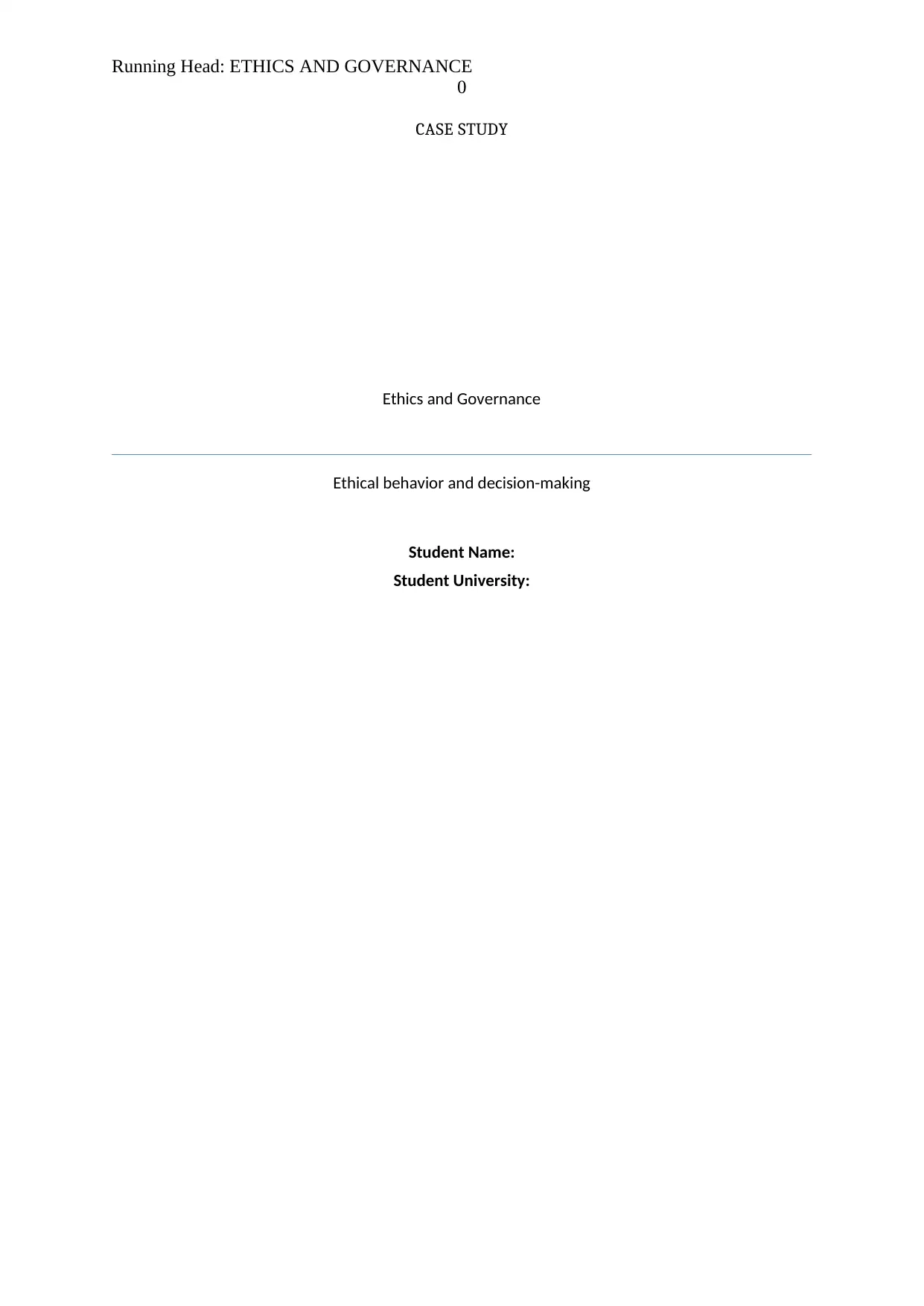
Running Head: ETHICS AND GOVERNANCE
0
CASE STUDY
Ethics and Governance
Ethical behavior and decision-making
Student Name:
Student University:
0
CASE STUDY
Ethics and Governance
Ethical behavior and decision-making
Student Name:
Student University:
Paraphrase This Document
Need a fresh take? Get an instant paraphrase of this document with our AI Paraphraser
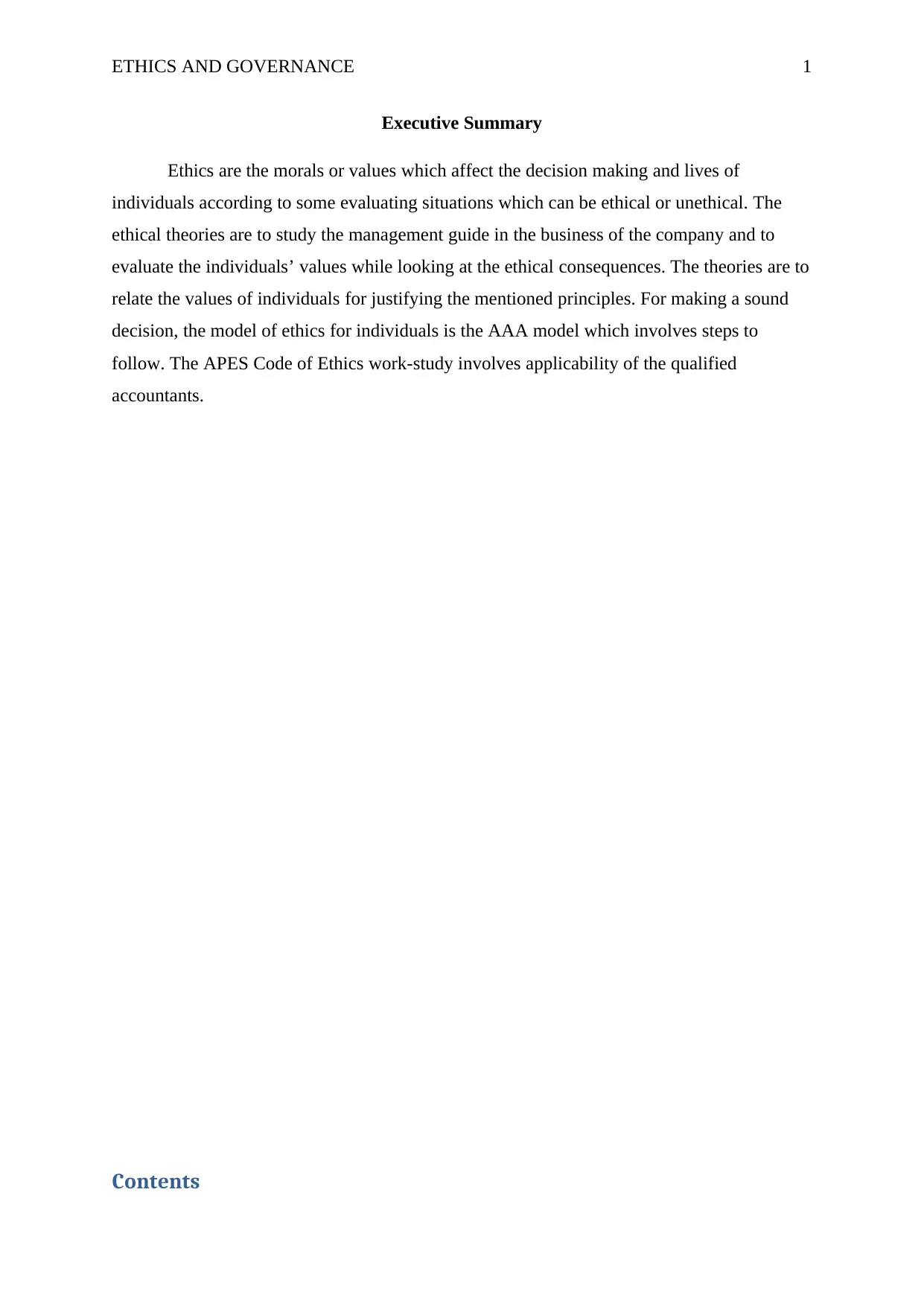
ETHICS AND GOVERNANCE 1
Executive Summary
Ethics are the morals or values which affect the decision making and lives of
individuals according to some evaluating situations which can be ethical or unethical. The
ethical theories are to study the management guide in the business of the company and to
evaluate the individuals’ values while looking at the ethical consequences. The theories are to
relate the values of individuals for justifying the mentioned principles. For making a sound
decision, the model of ethics for individuals is the AAA model which involves steps to
follow. The APES Code of Ethics work-study involves applicability of the qualified
accountants.
Contents
Executive Summary
Ethics are the morals or values which affect the decision making and lives of
individuals according to some evaluating situations which can be ethical or unethical. The
ethical theories are to study the management guide in the business of the company and to
evaluate the individuals’ values while looking at the ethical consequences. The theories are to
relate the values of individuals for justifying the mentioned principles. For making a sound
decision, the model of ethics for individuals is the AAA model which involves steps to
follow. The APES Code of Ethics work-study involves applicability of the qualified
accountants.
Contents
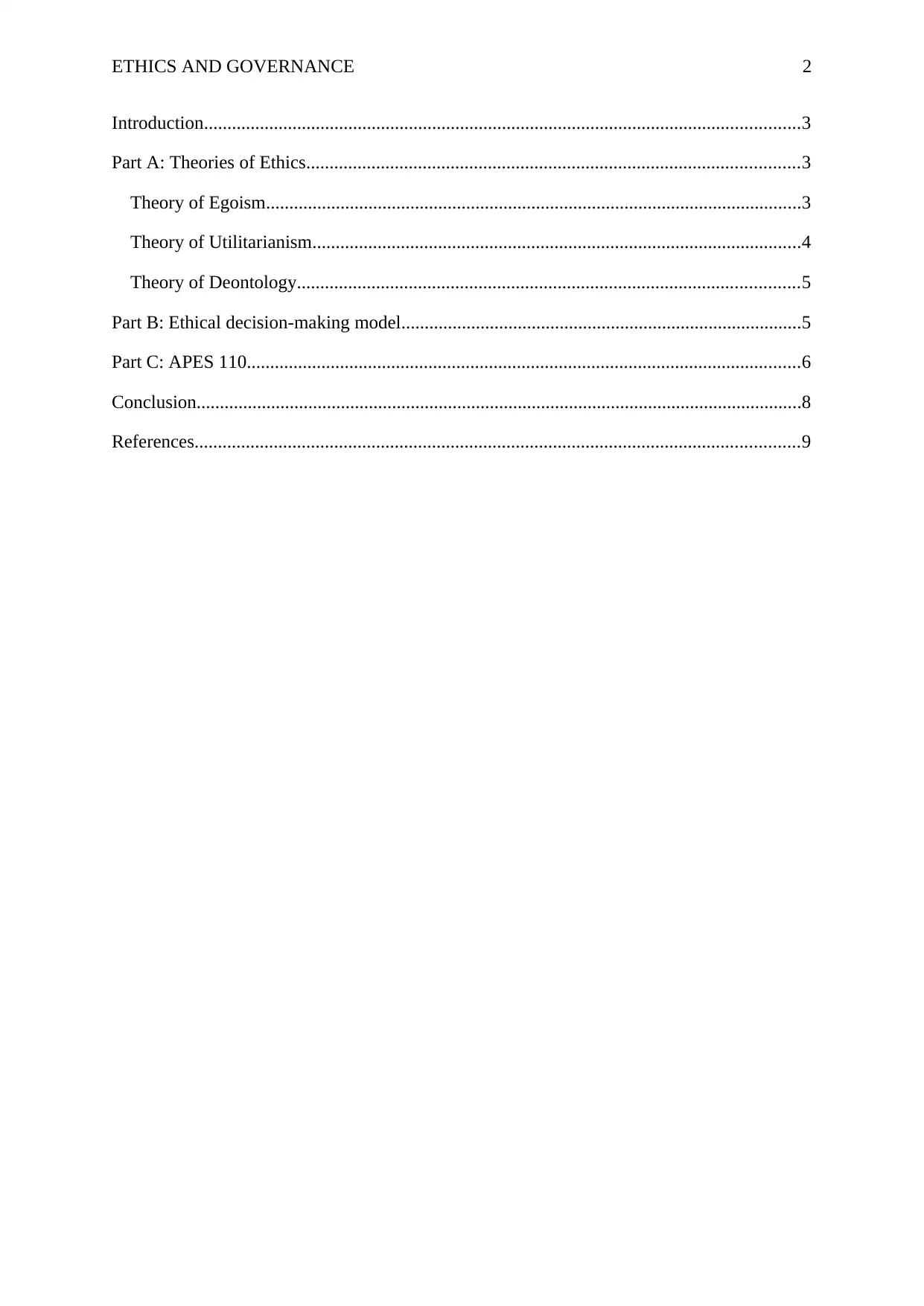
ETHICS AND GOVERNANCE 2
Introduction................................................................................................................................3
Part A: Theories of Ethics..........................................................................................................3
Theory of Egoism...................................................................................................................3
Theory of Utilitarianism.........................................................................................................4
Theory of Deontology............................................................................................................5
Part B: Ethical decision-making model......................................................................................5
Part C: APES 110.......................................................................................................................6
Conclusion..................................................................................................................................8
References..................................................................................................................................9
Introduction................................................................................................................................3
Part A: Theories of Ethics..........................................................................................................3
Theory of Egoism...................................................................................................................3
Theory of Utilitarianism.........................................................................................................4
Theory of Deontology............................................................................................................5
Part B: Ethical decision-making model......................................................................................5
Part C: APES 110.......................................................................................................................6
Conclusion..................................................................................................................................8
References..................................................................................................................................9
⊘ This is a preview!⊘
Do you want full access?
Subscribe today to unlock all pages.

Trusted by 1+ million students worldwide
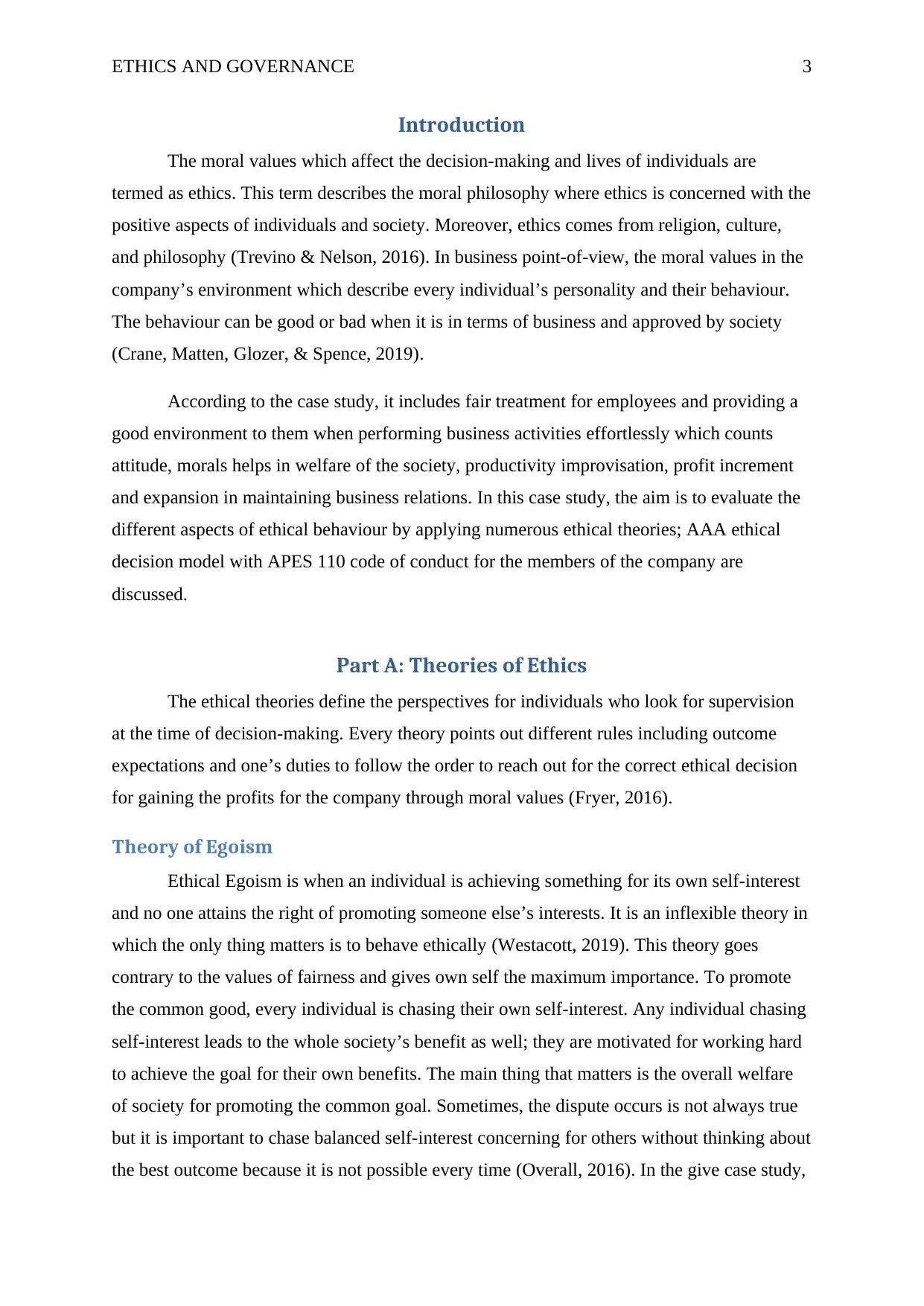
ETHICS AND GOVERNANCE 3
Introduction
The moral values which affect the decision-making and lives of individuals are
termed as ethics. This term describes the moral philosophy where ethics is concerned with the
positive aspects of individuals and society. Moreover, ethics comes from religion, culture,
and philosophy (Trevino & Nelson, 2016). In business point-of-view, the moral values in the
company’s environment which describe every individual’s personality and their behaviour.
The behaviour can be good or bad when it is in terms of business and approved by society
(Crane, Matten, Glozer, & Spence, 2019).
According to the case study, it includes fair treatment for employees and providing a
good environment to them when performing business activities effortlessly which counts
attitude, morals helps in welfare of the society, productivity improvisation, profit increment
and expansion in maintaining business relations. In this case study, the aim is to evaluate the
different aspects of ethical behaviour by applying numerous ethical theories; AAA ethical
decision model with APES 110 code of conduct for the members of the company are
discussed.
Part A: Theories of Ethics
The ethical theories define the perspectives for individuals who look for supervision
at the time of decision-making. Every theory points out different rules including outcome
expectations and one’s duties to follow the order to reach out for the correct ethical decision
for gaining the profits for the company through moral values (Fryer, 2016).
Theory of Egoism
Ethical Egoism is when an individual is achieving something for its own self-interest
and no one attains the right of promoting someone else’s interests. It is an inflexible theory in
which the only thing matters is to behave ethically (Westacott, 2019). This theory goes
contrary to the values of fairness and gives own self the maximum importance. To promote
the common good, every individual is chasing their own self-interest. Any individual chasing
self-interest leads to the whole society’s benefit as well; they are motivated for working hard
to achieve the goal for their own benefits. The main thing that matters is the overall welfare
of society for promoting the common goal. Sometimes, the dispute occurs is not always true
but it is important to chase balanced self-interest concerning for others without thinking about
the best outcome because it is not possible every time (Overall, 2016). In the give case study,
Introduction
The moral values which affect the decision-making and lives of individuals are
termed as ethics. This term describes the moral philosophy where ethics is concerned with the
positive aspects of individuals and society. Moreover, ethics comes from religion, culture,
and philosophy (Trevino & Nelson, 2016). In business point-of-view, the moral values in the
company’s environment which describe every individual’s personality and their behaviour.
The behaviour can be good or bad when it is in terms of business and approved by society
(Crane, Matten, Glozer, & Spence, 2019).
According to the case study, it includes fair treatment for employees and providing a
good environment to them when performing business activities effortlessly which counts
attitude, morals helps in welfare of the society, productivity improvisation, profit increment
and expansion in maintaining business relations. In this case study, the aim is to evaluate the
different aspects of ethical behaviour by applying numerous ethical theories; AAA ethical
decision model with APES 110 code of conduct for the members of the company are
discussed.
Part A: Theories of Ethics
The ethical theories define the perspectives for individuals who look for supervision
at the time of decision-making. Every theory points out different rules including outcome
expectations and one’s duties to follow the order to reach out for the correct ethical decision
for gaining the profits for the company through moral values (Fryer, 2016).
Theory of Egoism
Ethical Egoism is when an individual is achieving something for its own self-interest
and no one attains the right of promoting someone else’s interests. It is an inflexible theory in
which the only thing matters is to behave ethically (Westacott, 2019). This theory goes
contrary to the values of fairness and gives own self the maximum importance. To promote
the common good, every individual is chasing their own self-interest. Any individual chasing
self-interest leads to the whole society’s benefit as well; they are motivated for working hard
to achieve the goal for their own benefits. The main thing that matters is the overall welfare
of society for promoting the common goal. Sometimes, the dispute occurs is not always true
but it is important to chase balanced self-interest concerning for others without thinking about
the best outcome because it is not possible every time (Overall, 2016). In the give case study,
Paraphrase This Document
Need a fresh take? Get an instant paraphrase of this document with our AI Paraphraser
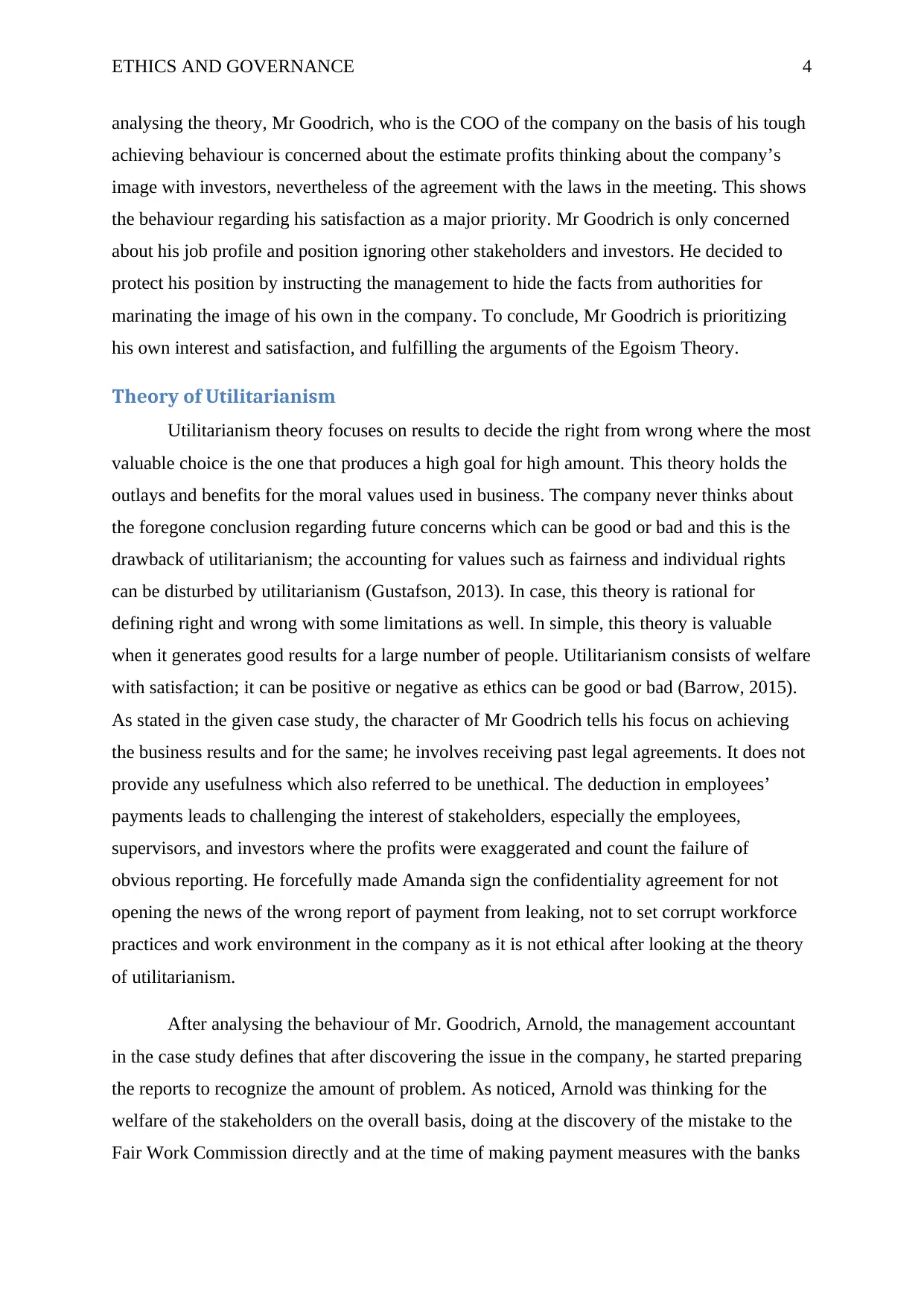
ETHICS AND GOVERNANCE 4
analysing the theory, Mr Goodrich, who is the COO of the company on the basis of his tough
achieving behaviour is concerned about the estimate profits thinking about the company’s
image with investors, nevertheless of the agreement with the laws in the meeting. This shows
the behaviour regarding his satisfaction as a major priority. Mr Goodrich is only concerned
about his job profile and position ignoring other stakeholders and investors. He decided to
protect his position by instructing the management to hide the facts from authorities for
marinating the image of his own in the company. To conclude, Mr Goodrich is prioritizing
his own interest and satisfaction, and fulfilling the arguments of the Egoism Theory.
Theory of Utilitarianism
Utilitarianism theory focuses on results to decide the right from wrong where the most
valuable choice is the one that produces a high goal for high amount. This theory holds the
outlays and benefits for the moral values used in business. The company never thinks about
the foregone conclusion regarding future concerns which can be good or bad and this is the
drawback of utilitarianism; the accounting for values such as fairness and individual rights
can be disturbed by utilitarianism (Gustafson, 2013). In case, this theory is rational for
defining right and wrong with some limitations as well. In simple, this theory is valuable
when it generates good results for a large number of people. Utilitarianism consists of welfare
with satisfaction; it can be positive or negative as ethics can be good or bad (Barrow, 2015).
As stated in the given case study, the character of Mr Goodrich tells his focus on achieving
the business results and for the same; he involves receiving past legal agreements. It does not
provide any usefulness which also referred to be unethical. The deduction in employees’
payments leads to challenging the interest of stakeholders, especially the employees,
supervisors, and investors where the profits were exaggerated and count the failure of
obvious reporting. He forcefully made Amanda sign the confidentiality agreement for not
opening the news of the wrong report of payment from leaking, not to set corrupt workforce
practices and work environment in the company as it is not ethical after looking at the theory
of utilitarianism.
After analysing the behaviour of Mr. Goodrich, Arnold, the management accountant
in the case study defines that after discovering the issue in the company, he started preparing
the reports to recognize the amount of problem. As noticed, Arnold was thinking for the
welfare of the stakeholders on the overall basis, doing at the discovery of the mistake to the
Fair Work Commission directly and at the time of making payment measures with the banks
analysing the theory, Mr Goodrich, who is the COO of the company on the basis of his tough
achieving behaviour is concerned about the estimate profits thinking about the company’s
image with investors, nevertheless of the agreement with the laws in the meeting. This shows
the behaviour regarding his satisfaction as a major priority. Mr Goodrich is only concerned
about his job profile and position ignoring other stakeholders and investors. He decided to
protect his position by instructing the management to hide the facts from authorities for
marinating the image of his own in the company. To conclude, Mr Goodrich is prioritizing
his own interest and satisfaction, and fulfilling the arguments of the Egoism Theory.
Theory of Utilitarianism
Utilitarianism theory focuses on results to decide the right from wrong where the most
valuable choice is the one that produces a high goal for high amount. This theory holds the
outlays and benefits for the moral values used in business. The company never thinks about
the foregone conclusion regarding future concerns which can be good or bad and this is the
drawback of utilitarianism; the accounting for values such as fairness and individual rights
can be disturbed by utilitarianism (Gustafson, 2013). In case, this theory is rational for
defining right and wrong with some limitations as well. In simple, this theory is valuable
when it generates good results for a large number of people. Utilitarianism consists of welfare
with satisfaction; it can be positive or negative as ethics can be good or bad (Barrow, 2015).
As stated in the given case study, the character of Mr Goodrich tells his focus on achieving
the business results and for the same; he involves receiving past legal agreements. It does not
provide any usefulness which also referred to be unethical. The deduction in employees’
payments leads to challenging the interest of stakeholders, especially the employees,
supervisors, and investors where the profits were exaggerated and count the failure of
obvious reporting. He forcefully made Amanda sign the confidentiality agreement for not
opening the news of the wrong report of payment from leaking, not to set corrupt workforce
practices and work environment in the company as it is not ethical after looking at the theory
of utilitarianism.
After analysing the behaviour of Mr. Goodrich, Arnold, the management accountant
in the case study defines that after discovering the issue in the company, he started preparing
the reports to recognize the amount of problem. As noticed, Arnold was thinking for the
welfare of the stakeholders on the overall basis, doing at the discovery of the mistake to the
Fair Work Commission directly and at the time of making payment measures with the banks
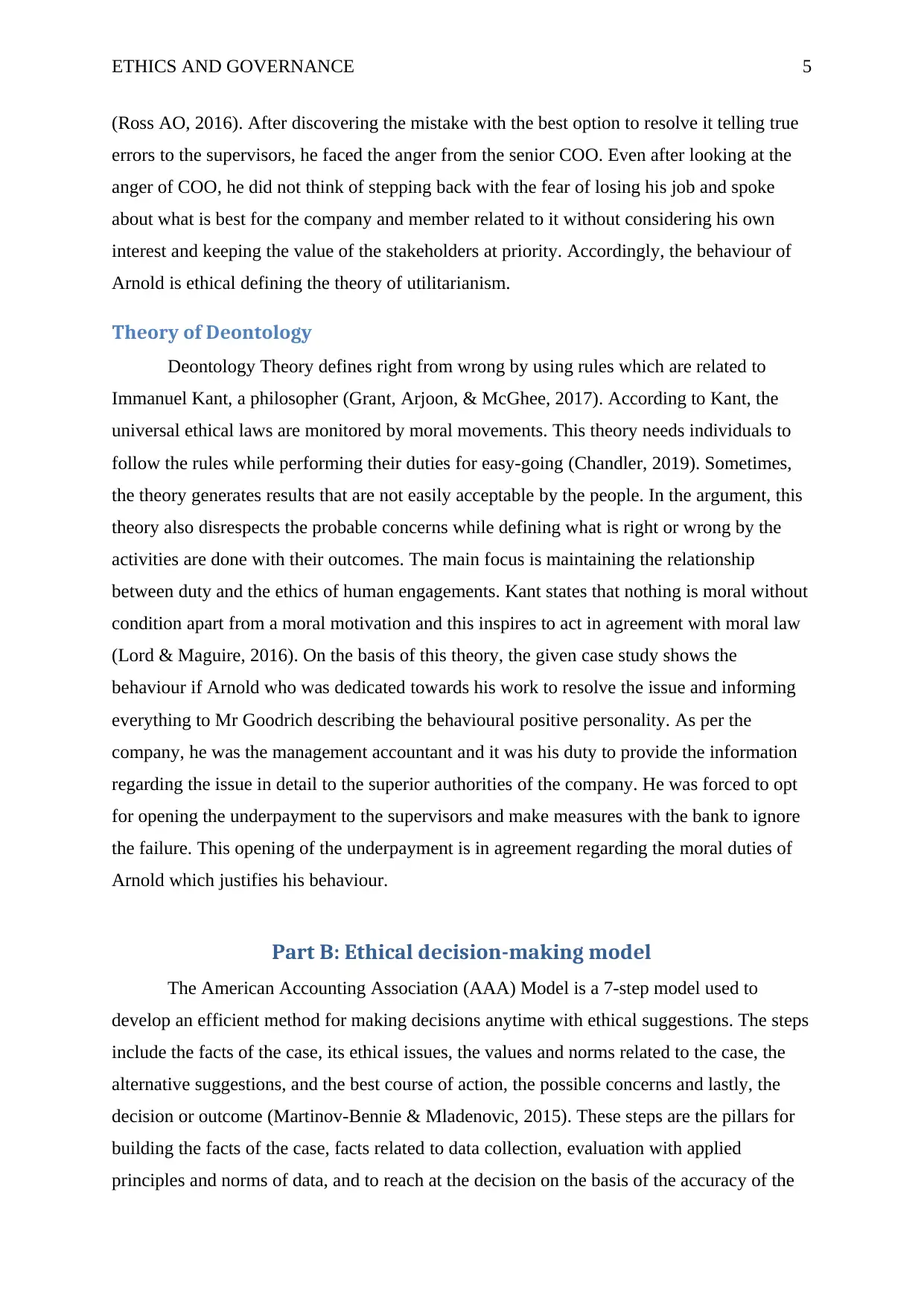
ETHICS AND GOVERNANCE 5
(Ross AO, 2016). After discovering the mistake with the best option to resolve it telling true
errors to the supervisors, he faced the anger from the senior COO. Even after looking at the
anger of COO, he did not think of stepping back with the fear of losing his job and spoke
about what is best for the company and member related to it without considering his own
interest and keeping the value of the stakeholders at priority. Accordingly, the behaviour of
Arnold is ethical defining the theory of utilitarianism.
Theory of Deontology
Deontology Theory defines right from wrong by using rules which are related to
Immanuel Kant, a philosopher (Grant, Arjoon, & McGhee, 2017). According to Kant, the
universal ethical laws are monitored by moral movements. This theory needs individuals to
follow the rules while performing their duties for easy-going (Chandler, 2019). Sometimes,
the theory generates results that are not easily acceptable by the people. In the argument, this
theory also disrespects the probable concerns while defining what is right or wrong by the
activities are done with their outcomes. The main focus is maintaining the relationship
between duty and the ethics of human engagements. Kant states that nothing is moral without
condition apart from a moral motivation and this inspires to act in agreement with moral law
(Lord & Maguire, 2016). On the basis of this theory, the given case study shows the
behaviour if Arnold who was dedicated towards his work to resolve the issue and informing
everything to Mr Goodrich describing the behavioural positive personality. As per the
company, he was the management accountant and it was his duty to provide the information
regarding the issue in detail to the superior authorities of the company. He was forced to opt
for opening the underpayment to the supervisors and make measures with the bank to ignore
the failure. This opening of the underpayment is in agreement regarding the moral duties of
Arnold which justifies his behaviour.
Part B: Ethical decision-making model
The American Accounting Association (AAA) Model is a 7-step model used to
develop an efficient method for making decisions anytime with ethical suggestions. The steps
include the facts of the case, its ethical issues, the values and norms related to the case, the
alternative suggestions, and the best course of action, the possible concerns and lastly, the
decision or outcome (Martinov-Bennie & Mladenovic, 2015). These steps are the pillars for
building the facts of the case, facts related to data collection, evaluation with applied
principles and norms of data, and to reach at the decision on the basis of the accuracy of the
(Ross AO, 2016). After discovering the mistake with the best option to resolve it telling true
errors to the supervisors, he faced the anger from the senior COO. Even after looking at the
anger of COO, he did not think of stepping back with the fear of losing his job and spoke
about what is best for the company and member related to it without considering his own
interest and keeping the value of the stakeholders at priority. Accordingly, the behaviour of
Arnold is ethical defining the theory of utilitarianism.
Theory of Deontology
Deontology Theory defines right from wrong by using rules which are related to
Immanuel Kant, a philosopher (Grant, Arjoon, & McGhee, 2017). According to Kant, the
universal ethical laws are monitored by moral movements. This theory needs individuals to
follow the rules while performing their duties for easy-going (Chandler, 2019). Sometimes,
the theory generates results that are not easily acceptable by the people. In the argument, this
theory also disrespects the probable concerns while defining what is right or wrong by the
activities are done with their outcomes. The main focus is maintaining the relationship
between duty and the ethics of human engagements. Kant states that nothing is moral without
condition apart from a moral motivation and this inspires to act in agreement with moral law
(Lord & Maguire, 2016). On the basis of this theory, the given case study shows the
behaviour if Arnold who was dedicated towards his work to resolve the issue and informing
everything to Mr Goodrich describing the behavioural positive personality. As per the
company, he was the management accountant and it was his duty to provide the information
regarding the issue in detail to the superior authorities of the company. He was forced to opt
for opening the underpayment to the supervisors and make measures with the bank to ignore
the failure. This opening of the underpayment is in agreement regarding the moral duties of
Arnold which justifies his behaviour.
Part B: Ethical decision-making model
The American Accounting Association (AAA) Model is a 7-step model used to
develop an efficient method for making decisions anytime with ethical suggestions. The steps
include the facts of the case, its ethical issues, the values and norms related to the case, the
alternative suggestions, and the best course of action, the possible concerns and lastly, the
decision or outcome (Martinov-Bennie & Mladenovic, 2015). These steps are the pillars for
building the facts of the case, facts related to data collection, evaluation with applied
principles and norms of data, and to reach at the decision on the basis of the accuracy of the
⊘ This is a preview!⊘
Do you want full access?
Subscribe today to unlock all pages.

Trusted by 1+ million students worldwide
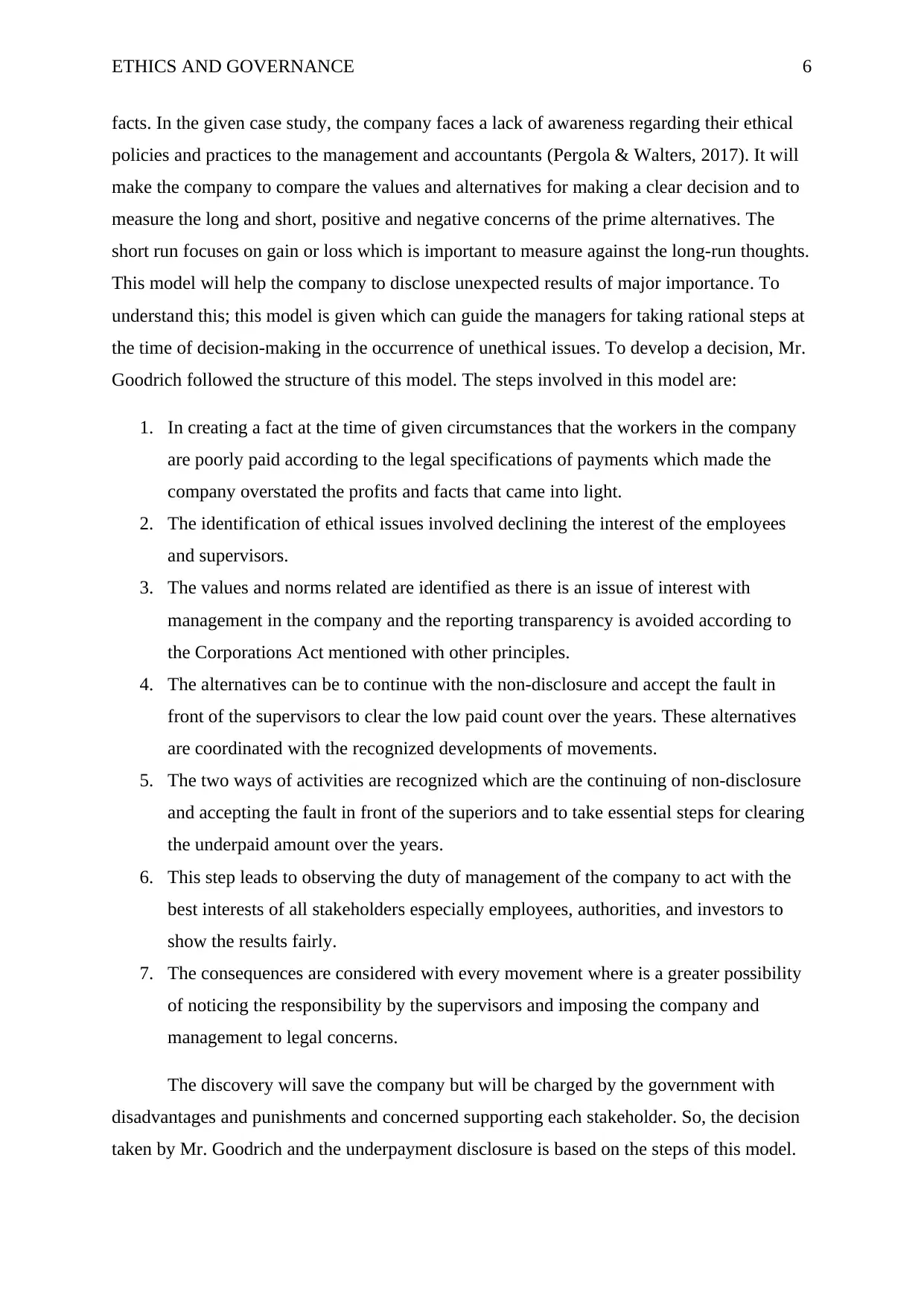
ETHICS AND GOVERNANCE 6
facts. In the given case study, the company faces a lack of awareness regarding their ethical
policies and practices to the management and accountants (Pergola & Walters, 2017). It will
make the company to compare the values and alternatives for making a clear decision and to
measure the long and short, positive and negative concerns of the prime alternatives. The
short run focuses on gain or loss which is important to measure against the long-run thoughts.
This model will help the company to disclose unexpected results of major importance. To
understand this; this model is given which can guide the managers for taking rational steps at
the time of decision-making in the occurrence of unethical issues. To develop a decision, Mr.
Goodrich followed the structure of this model. The steps involved in this model are:
1. In creating a fact at the time of given circumstances that the workers in the company
are poorly paid according to the legal specifications of payments which made the
company overstated the profits and facts that came into light.
2. The identification of ethical issues involved declining the interest of the employees
and supervisors.
3. The values and norms related are identified as there is an issue of interest with
management in the company and the reporting transparency is avoided according to
the Corporations Act mentioned with other principles.
4. The alternatives can be to continue with the non-disclosure and accept the fault in
front of the supervisors to clear the low paid count over the years. These alternatives
are coordinated with the recognized developments of movements.
5. The two ways of activities are recognized which are the continuing of non-disclosure
and accepting the fault in front of the superiors and to take essential steps for clearing
the underpaid amount over the years.
6. This step leads to observing the duty of management of the company to act with the
best interests of all stakeholders especially employees, authorities, and investors to
show the results fairly.
7. The consequences are considered with every movement where is a greater possibility
of noticing the responsibility by the supervisors and imposing the company and
management to legal concerns.
The discovery will save the company but will be charged by the government with
disadvantages and punishments and concerned supporting each stakeholder. So, the decision
taken by Mr. Goodrich and the underpayment disclosure is based on the steps of this model.
facts. In the given case study, the company faces a lack of awareness regarding their ethical
policies and practices to the management and accountants (Pergola & Walters, 2017). It will
make the company to compare the values and alternatives for making a clear decision and to
measure the long and short, positive and negative concerns of the prime alternatives. The
short run focuses on gain or loss which is important to measure against the long-run thoughts.
This model will help the company to disclose unexpected results of major importance. To
understand this; this model is given which can guide the managers for taking rational steps at
the time of decision-making in the occurrence of unethical issues. To develop a decision, Mr.
Goodrich followed the structure of this model. The steps involved in this model are:
1. In creating a fact at the time of given circumstances that the workers in the company
are poorly paid according to the legal specifications of payments which made the
company overstated the profits and facts that came into light.
2. The identification of ethical issues involved declining the interest of the employees
and supervisors.
3. The values and norms related are identified as there is an issue of interest with
management in the company and the reporting transparency is avoided according to
the Corporations Act mentioned with other principles.
4. The alternatives can be to continue with the non-disclosure and accept the fault in
front of the supervisors to clear the low paid count over the years. These alternatives
are coordinated with the recognized developments of movements.
5. The two ways of activities are recognized which are the continuing of non-disclosure
and accepting the fault in front of the superiors and to take essential steps for clearing
the underpaid amount over the years.
6. This step leads to observing the duty of management of the company to act with the
best interests of all stakeholders especially employees, authorities, and investors to
show the results fairly.
7. The consequences are considered with every movement where is a greater possibility
of noticing the responsibility by the supervisors and imposing the company and
management to legal concerns.
The discovery will save the company but will be charged by the government with
disadvantages and punishments and concerned supporting each stakeholder. So, the decision
taken by Mr. Goodrich and the underpayment disclosure is based on the steps of this model.
Paraphrase This Document
Need a fresh take? Get an instant paraphrase of this document with our AI Paraphraser
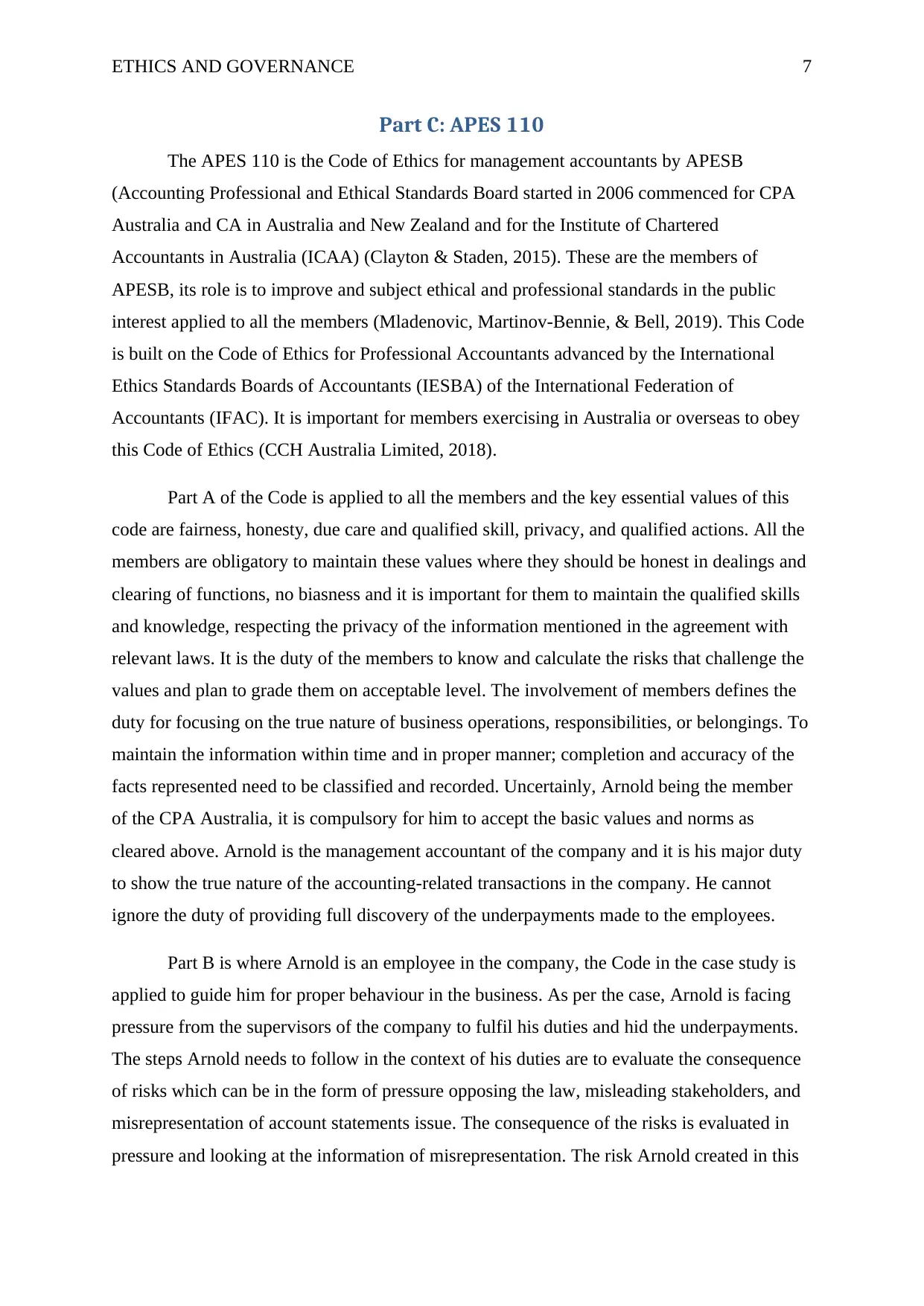
ETHICS AND GOVERNANCE 7
Part C: APES 110
The APES 110 is the Code of Ethics for management accountants by APESB
(Accounting Professional and Ethical Standards Board started in 2006 commenced for CPA
Australia and CA in Australia and New Zealand and for the Institute of Chartered
Accountants in Australia (ICAA) (Clayton & Staden, 2015). These are the members of
APESB, its role is to improve and subject ethical and professional standards in the public
interest applied to all the members (Mladenovic, Martinov-Bennie, & Bell, 2019). This Code
is built on the Code of Ethics for Professional Accountants advanced by the International
Ethics Standards Boards of Accountants (IESBA) of the International Federation of
Accountants (IFAC). It is important for members exercising in Australia or overseas to obey
this Code of Ethics (CCH Australia Limited, 2018).
Part A of the Code is applied to all the members and the key essential values of this
code are fairness, honesty, due care and qualified skill, privacy, and qualified actions. All the
members are obligatory to maintain these values where they should be honest in dealings and
clearing of functions, no biasness and it is important for them to maintain the qualified skills
and knowledge, respecting the privacy of the information mentioned in the agreement with
relevant laws. It is the duty of the members to know and calculate the risks that challenge the
values and plan to grade them on acceptable level. The involvement of members defines the
duty for focusing on the true nature of business operations, responsibilities, or belongings. To
maintain the information within time and in proper manner; completion and accuracy of the
facts represented need to be classified and recorded. Uncertainly, Arnold being the member
of the CPA Australia, it is compulsory for him to accept the basic values and norms as
cleared above. Arnold is the management accountant of the company and it is his major duty
to show the true nature of the accounting-related transactions in the company. He cannot
ignore the duty of providing full discovery of the underpayments made to the employees.
Part B is where Arnold is an employee in the company, the Code in the case study is
applied to guide him for proper behaviour in the business. As per the case, Arnold is facing
pressure from the supervisors of the company to fulfil his duties and hid the underpayments.
The steps Arnold needs to follow in the context of his duties are to evaluate the consequence
of risks which can be in the form of pressure opposing the law, misleading stakeholders, and
misrepresentation of account statements issue. The consequence of the risks is evaluated in
pressure and looking at the information of misrepresentation. The risk Arnold created in this
Part C: APES 110
The APES 110 is the Code of Ethics for management accountants by APESB
(Accounting Professional and Ethical Standards Board started in 2006 commenced for CPA
Australia and CA in Australia and New Zealand and for the Institute of Chartered
Accountants in Australia (ICAA) (Clayton & Staden, 2015). These are the members of
APESB, its role is to improve and subject ethical and professional standards in the public
interest applied to all the members (Mladenovic, Martinov-Bennie, & Bell, 2019). This Code
is built on the Code of Ethics for Professional Accountants advanced by the International
Ethics Standards Boards of Accountants (IESBA) of the International Federation of
Accountants (IFAC). It is important for members exercising in Australia or overseas to obey
this Code of Ethics (CCH Australia Limited, 2018).
Part A of the Code is applied to all the members and the key essential values of this
code are fairness, honesty, due care and qualified skill, privacy, and qualified actions. All the
members are obligatory to maintain these values where they should be honest in dealings and
clearing of functions, no biasness and it is important for them to maintain the qualified skills
and knowledge, respecting the privacy of the information mentioned in the agreement with
relevant laws. It is the duty of the members to know and calculate the risks that challenge the
values and plan to grade them on acceptable level. The involvement of members defines the
duty for focusing on the true nature of business operations, responsibilities, or belongings. To
maintain the information within time and in proper manner; completion and accuracy of the
facts represented need to be classified and recorded. Uncertainly, Arnold being the member
of the CPA Australia, it is compulsory for him to accept the basic values and norms as
cleared above. Arnold is the management accountant of the company and it is his major duty
to show the true nature of the accounting-related transactions in the company. He cannot
ignore the duty of providing full discovery of the underpayments made to the employees.
Part B is where Arnold is an employee in the company, the Code in the case study is
applied to guide him for proper behaviour in the business. As per the case, Arnold is facing
pressure from the supervisors of the company to fulfil his duties and hid the underpayments.
The steps Arnold needs to follow in the context of his duties are to evaluate the consequence
of risks which can be in the form of pressure opposing the law, misleading stakeholders, and
misrepresentation of account statements issue. The consequence of the risks is evaluated in
pressure and looking at the information of misrepresentation. The risk Arnold created in this
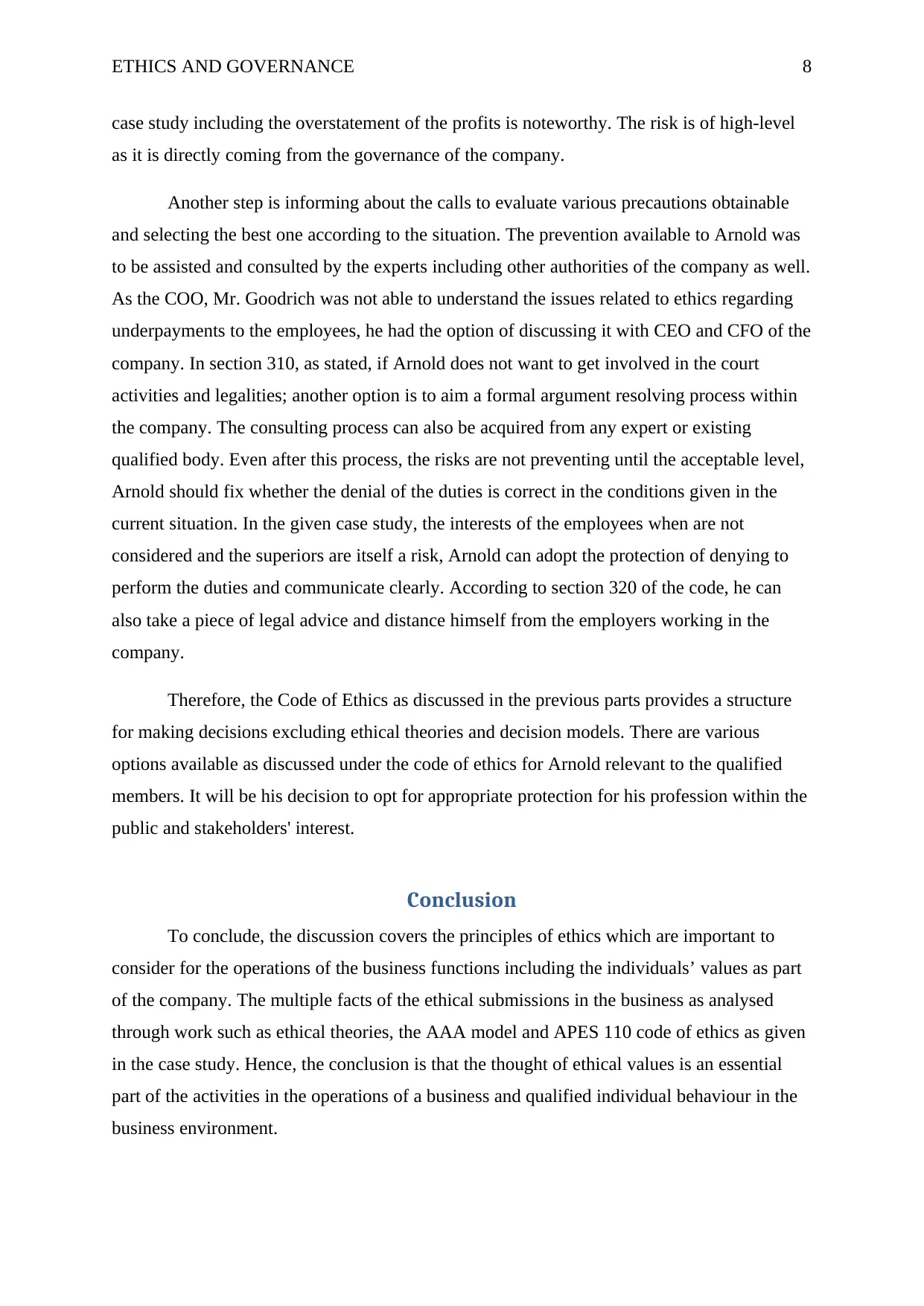
ETHICS AND GOVERNANCE 8
case study including the overstatement of the profits is noteworthy. The risk is of high-level
as it is directly coming from the governance of the company.
Another step is informing about the calls to evaluate various precautions obtainable
and selecting the best one according to the situation. The prevention available to Arnold was
to be assisted and consulted by the experts including other authorities of the company as well.
As the COO, Mr. Goodrich was not able to understand the issues related to ethics regarding
underpayments to the employees, he had the option of discussing it with CEO and CFO of the
company. In section 310, as stated, if Arnold does not want to get involved in the court
activities and legalities; another option is to aim a formal argument resolving process within
the company. The consulting process can also be acquired from any expert or existing
qualified body. Even after this process, the risks are not preventing until the acceptable level,
Arnold should fix whether the denial of the duties is correct in the conditions given in the
current situation. In the given case study, the interests of the employees when are not
considered and the superiors are itself a risk, Arnold can adopt the protection of denying to
perform the duties and communicate clearly. According to section 320 of the code, he can
also take a piece of legal advice and distance himself from the employers working in the
company.
Therefore, the Code of Ethics as discussed in the previous parts provides a structure
for making decisions excluding ethical theories and decision models. There are various
options available as discussed under the code of ethics for Arnold relevant to the qualified
members. It will be his decision to opt for appropriate protection for his profession within the
public and stakeholders' interest.
Conclusion
To conclude, the discussion covers the principles of ethics which are important to
consider for the operations of the business functions including the individuals’ values as part
of the company. The multiple facts of the ethical submissions in the business as analysed
through work such as ethical theories, the AAA model and APES 110 code of ethics as given
in the case study. Hence, the conclusion is that the thought of ethical values is an essential
part of the activities in the operations of a business and qualified individual behaviour in the
business environment.
case study including the overstatement of the profits is noteworthy. The risk is of high-level
as it is directly coming from the governance of the company.
Another step is informing about the calls to evaluate various precautions obtainable
and selecting the best one according to the situation. The prevention available to Arnold was
to be assisted and consulted by the experts including other authorities of the company as well.
As the COO, Mr. Goodrich was not able to understand the issues related to ethics regarding
underpayments to the employees, he had the option of discussing it with CEO and CFO of the
company. In section 310, as stated, if Arnold does not want to get involved in the court
activities and legalities; another option is to aim a formal argument resolving process within
the company. The consulting process can also be acquired from any expert or existing
qualified body. Even after this process, the risks are not preventing until the acceptable level,
Arnold should fix whether the denial of the duties is correct in the conditions given in the
current situation. In the given case study, the interests of the employees when are not
considered and the superiors are itself a risk, Arnold can adopt the protection of denying to
perform the duties and communicate clearly. According to section 320 of the code, he can
also take a piece of legal advice and distance himself from the employers working in the
company.
Therefore, the Code of Ethics as discussed in the previous parts provides a structure
for making decisions excluding ethical theories and decision models. There are various
options available as discussed under the code of ethics for Arnold relevant to the qualified
members. It will be his decision to opt for appropriate protection for his profession within the
public and stakeholders' interest.
Conclusion
To conclude, the discussion covers the principles of ethics which are important to
consider for the operations of the business functions including the individuals’ values as part
of the company. The multiple facts of the ethical submissions in the business as analysed
through work such as ethical theories, the AAA model and APES 110 code of ethics as given
in the case study. Hence, the conclusion is that the thought of ethical values is an essential
part of the activities in the operations of a business and qualified individual behaviour in the
business environment.
⊘ This is a preview!⊘
Do you want full access?
Subscribe today to unlock all pages.

Trusted by 1+ million students worldwide
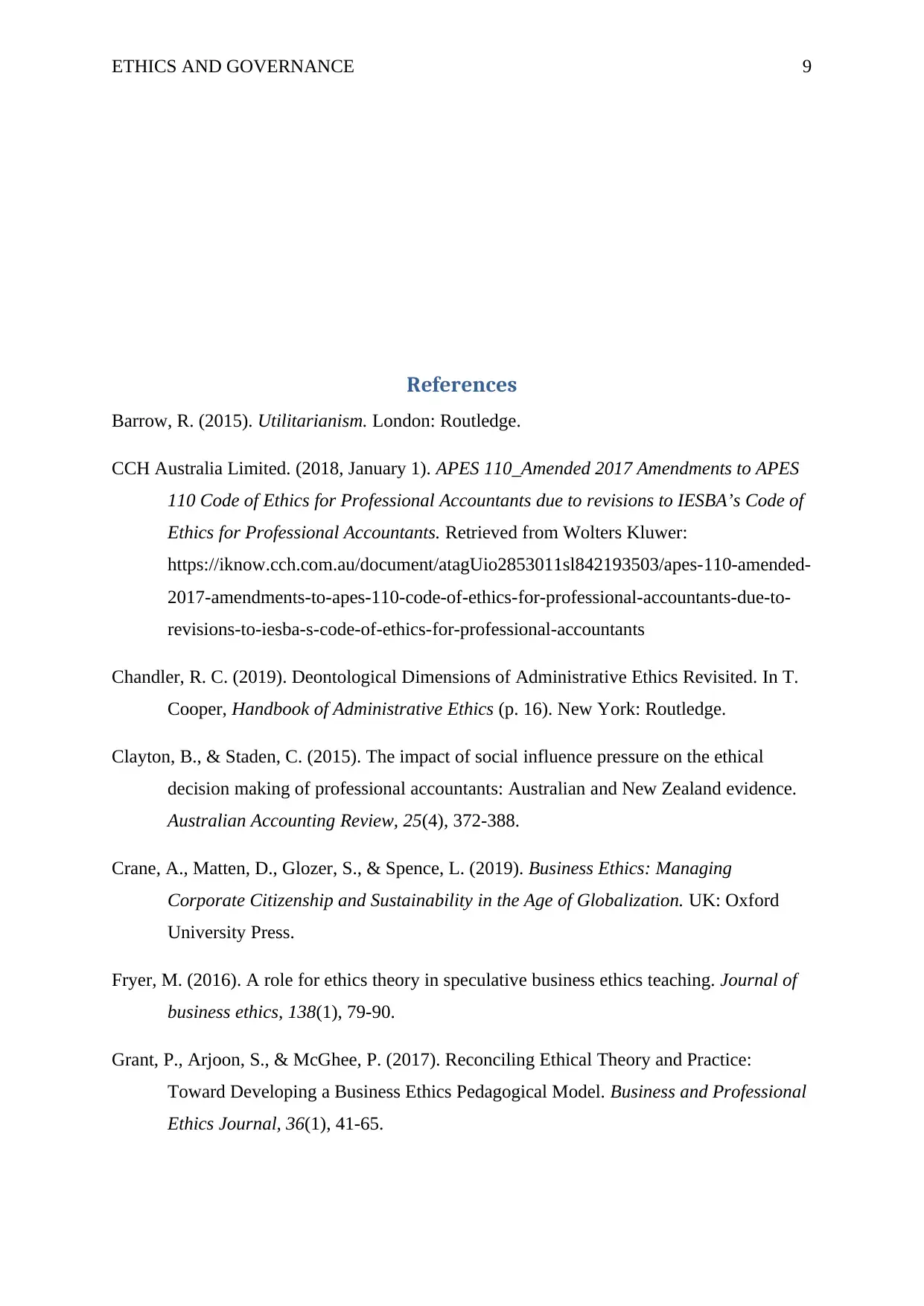
ETHICS AND GOVERNANCE 9
References
Barrow, R. (2015). Utilitarianism. London: Routledge.
CCH Australia Limited. (2018, January 1). APES 110_Amended 2017 Amendments to APES
110 Code of Ethics for Professional Accountants due to revisions to IESBA’s Code of
Ethics for Professional Accountants. Retrieved from Wolters Kluwer:
https://iknow.cch.com.au/document/atagUio2853011sl842193503/apes-110-amended-
2017-amendments-to-apes-110-code-of-ethics-for-professional-accountants-due-to-
revisions-to-iesba-s-code-of-ethics-for-professional-accountants
Chandler, R. C. (2019). Deontological Dimensions of Administrative Ethics Revisited. In T.
Cooper, Handbook of Administrative Ethics (p. 16). New York: Routledge.
Clayton, B., & Staden, C. (2015). The impact of social influence pressure on the ethical
decision making of professional accountants: Australian and New Zealand evidence.
Australian Accounting Review, 25(4), 372-388.
Crane, A., Matten, D., Glozer, S., & Spence, L. (2019). Business Ethics: Managing
Corporate Citizenship and Sustainability in the Age of Globalization. UK: Oxford
University Press.
Fryer, M. (2016). A role for ethics theory in speculative business ethics teaching. Journal of
business ethics, 138(1), 79-90.
Grant, P., Arjoon, S., & McGhee, P. (2017). Reconciling Ethical Theory and Practice:
Toward Developing a Business Ethics Pedagogical Model. Business and Professional
Ethics Journal, 36(1), 41-65.
References
Barrow, R. (2015). Utilitarianism. London: Routledge.
CCH Australia Limited. (2018, January 1). APES 110_Amended 2017 Amendments to APES
110 Code of Ethics for Professional Accountants due to revisions to IESBA’s Code of
Ethics for Professional Accountants. Retrieved from Wolters Kluwer:
https://iknow.cch.com.au/document/atagUio2853011sl842193503/apes-110-amended-
2017-amendments-to-apes-110-code-of-ethics-for-professional-accountants-due-to-
revisions-to-iesba-s-code-of-ethics-for-professional-accountants
Chandler, R. C. (2019). Deontological Dimensions of Administrative Ethics Revisited. In T.
Cooper, Handbook of Administrative Ethics (p. 16). New York: Routledge.
Clayton, B., & Staden, C. (2015). The impact of social influence pressure on the ethical
decision making of professional accountants: Australian and New Zealand evidence.
Australian Accounting Review, 25(4), 372-388.
Crane, A., Matten, D., Glozer, S., & Spence, L. (2019). Business Ethics: Managing
Corporate Citizenship and Sustainability in the Age of Globalization. UK: Oxford
University Press.
Fryer, M. (2016). A role for ethics theory in speculative business ethics teaching. Journal of
business ethics, 138(1), 79-90.
Grant, P., Arjoon, S., & McGhee, P. (2017). Reconciling Ethical Theory and Practice:
Toward Developing a Business Ethics Pedagogical Model. Business and Professional
Ethics Journal, 36(1), 41-65.
Paraphrase This Document
Need a fresh take? Get an instant paraphrase of this document with our AI Paraphraser
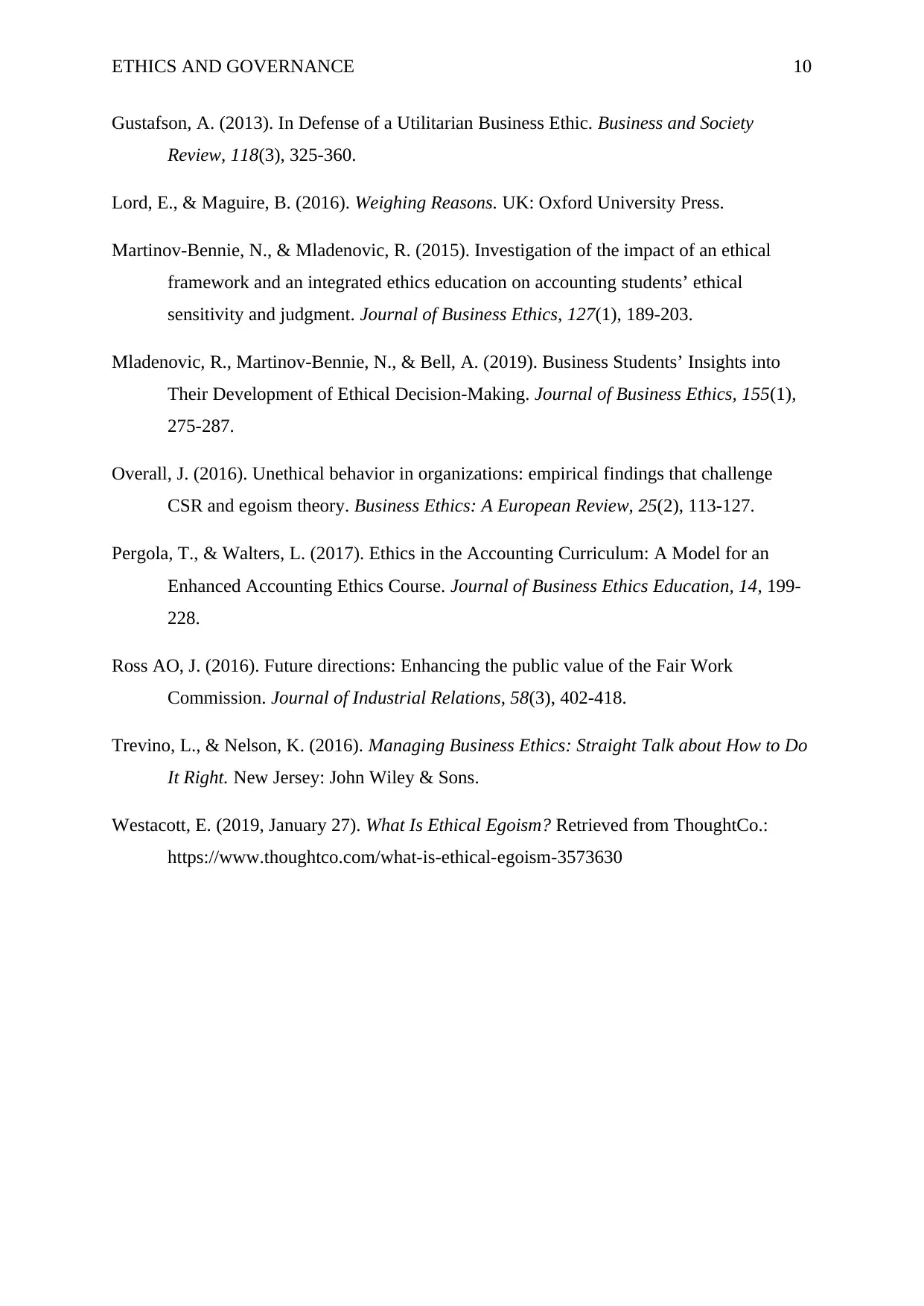
ETHICS AND GOVERNANCE 10
Gustafson, A. (2013). In Defense of a Utilitarian Business Ethic. Business and Society
Review, 118(3), 325-360.
Lord, E., & Maguire, B. (2016). Weighing Reasons. UK: Oxford University Press.
Martinov-Bennie, N., & Mladenovic, R. (2015). Investigation of the impact of an ethical
framework and an integrated ethics education on accounting students’ ethical
sensitivity and judgment. Journal of Business Ethics, 127(1), 189-203.
Mladenovic, R., Martinov-Bennie, N., & Bell, A. (2019). Business Students’ Insights into
Their Development of Ethical Decision-Making. Journal of Business Ethics, 155(1),
275-287.
Overall, J. (2016). Unethical behavior in organizations: empirical findings that challenge
CSR and egoism theory. Business Ethics: A European Review, 25(2), 113-127.
Pergola, T., & Walters, L. (2017). Ethics in the Accounting Curriculum: A Model for an
Enhanced Accounting Ethics Course. Journal of Business Ethics Education, 14, 199-
228.
Ross AO, J. (2016). Future directions: Enhancing the public value of the Fair Work
Commission. Journal of Industrial Relations, 58(3), 402-418.
Trevino, L., & Nelson, K. (2016). Managing Business Ethics: Straight Talk about How to Do
It Right. New Jersey: John Wiley & Sons.
Westacott, E. (2019, January 27). What Is Ethical Egoism? Retrieved from ThoughtCo.:
https://www.thoughtco.com/what-is-ethical-egoism-3573630
Gustafson, A. (2013). In Defense of a Utilitarian Business Ethic. Business and Society
Review, 118(3), 325-360.
Lord, E., & Maguire, B. (2016). Weighing Reasons. UK: Oxford University Press.
Martinov-Bennie, N., & Mladenovic, R. (2015). Investigation of the impact of an ethical
framework and an integrated ethics education on accounting students’ ethical
sensitivity and judgment. Journal of Business Ethics, 127(1), 189-203.
Mladenovic, R., Martinov-Bennie, N., & Bell, A. (2019). Business Students’ Insights into
Their Development of Ethical Decision-Making. Journal of Business Ethics, 155(1),
275-287.
Overall, J. (2016). Unethical behavior in organizations: empirical findings that challenge
CSR and egoism theory. Business Ethics: A European Review, 25(2), 113-127.
Pergola, T., & Walters, L. (2017). Ethics in the Accounting Curriculum: A Model for an
Enhanced Accounting Ethics Course. Journal of Business Ethics Education, 14, 199-
228.
Ross AO, J. (2016). Future directions: Enhancing the public value of the Fair Work
Commission. Journal of Industrial Relations, 58(3), 402-418.
Trevino, L., & Nelson, K. (2016). Managing Business Ethics: Straight Talk about How to Do
It Right. New Jersey: John Wiley & Sons.
Westacott, E. (2019, January 27). What Is Ethical Egoism? Retrieved from ThoughtCo.:
https://www.thoughtco.com/what-is-ethical-egoism-3573630
1 out of 11
Related Documents
Your All-in-One AI-Powered Toolkit for Academic Success.
+13062052269
info@desklib.com
Available 24*7 on WhatsApp / Email
![[object Object]](/_next/static/media/star-bottom.7253800d.svg)
Unlock your academic potential
Copyright © 2020–2025 A2Z Services. All Rights Reserved. Developed and managed by ZUCOL.





